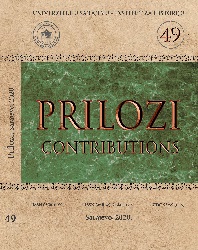Oko kuge u Bosni 1763–1764. godine
Concerning Plague in Bosnia 1763-1764.
Author(s): Nenad FilipovićSubject(s): Social history, Health and medicine and law, 18th Century, The Ottoman Empire
Published by: Institut za istoriju
Keywords: Plague; Banja Luka; Ljubinje; Trebinje; Stolac; Gacko; epidemics; prices; Smail-beg Džennetić;
Summary/Abstract: In this paper, two sources are analysed. They both were composed in the Ottoman language in 1763-1764. They deal with the outbreaks of plague in two Bosnian towns, widely distant from each other: Banja Luka and Ljubinje. The first source is an official judge report (i‘lām) of the judge of Banja Luka to the Vizier of Bosnia Muhsin-zâde Mehmed Paşa. It was dated in 13 rebî’u-l-âhir 1177 A. H. / 21 October 1763 A. D.. The report was concerned with the offical taking into the court custody of two „ legaly mature virgins“ Ümmihân and Ümmigülsûm, from the Arnaudiyye quarter in the city of Banja Luka. These girls, having feared of contracting the plague, flead the city in the direction of the Ottoman military camp which was bivuacqing somewhere between the cities of Travnik and Banja Luka. The Qapudân and Mütesellim of Banja Luka, one person actually, arrested them while they were travelling. He delivered them to the court of Banja Luka. They claimed they did not transmit the disease to anybody being herselves healthy, and the judge of Banja Luka referred the case for the final decision to the Vizier of Bosnia and his Dîvân in Travnik. The second source is a private letter by certain Ömer, a deputy judge (nā’ib) in the town of Ljubinje in Hercegovina, sent from Trebinje to Sarajevo. He took refuge in Trebinje upon the plague outbreak in Ljubinje. The addressee of his letter was the Mütesellim of Sarajevo, Smail-beg Džennetić, and the letter was composed in 9 zî-’l-ka’de 1177 A. H. / 10 May 1764 A. D. In his letter, Ömer reports about the spread of plague, the degree of mortality, the flight of population, especially of the Christian raja, prices et cetera in Ljubinje, Trebinje, Stolac, Gacko etc. The letter is also a brilliant source for the history of mentalities of the era. It helps understanding the attitudes of the people of the era towards disease and epidemics. The paper provides the critical editions of the Ottoman texts of both sources as well as their commented translations in Bosnian. The sources are interpreted in a framework informed by microhistory and the Geertzian „thick description“.
Journal: Prilozi
- Issue Year: 2020
- Issue No: 49
- Page Range: 45-87
- Page Count: 43
- Language: Bosnian

